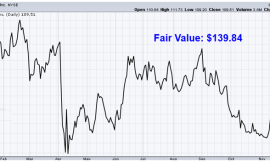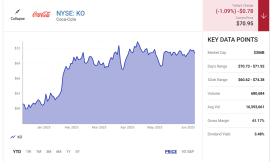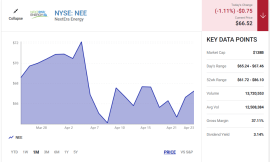I keep hearing about the widening wealth divide in the US.
As someone who grew up in abject poverty but now enjoys the benefits of wealth, I find this to be misleading topic.
Yes, there’s a huge (and growing) divide between the rich and the poor.
Always has been, always will be.
However, the US offers nearly unlimited opportunities for regular people to cross the chasm and move from poor to rich – in one lifetime.
I’ve traveled the world, and I know of no other country that offers anything like this to its citizenry.
A lot of this uniqueness comes down to the US’s capital markets, which are the largest and most robust anywhere.
Zooming in even further, I think employing the dividend growth investing strategy is the most effective way to cross that chasm.
This long-term investment strategy, which advocates for buying and holding shares in high-quality businesses paying shareholders safe, growing dividends, is available to all of us, and it’s an incredibly powerful way to build wealth and passive income.
You can find hundreds of US-listed stocks that qualify for the strategy by perusing the Dividend Champions, Contenders, and Challengers list.
This is a curated list containing rich data on US-listed stocks that have raised dividends each year for at least the last five consecutive years.
The effectiveness of this strategy largely lies in the way in which it almost automatically leads investors to great businesses (due to how growing dividends tend to require growing profits to sustain over time), as well as how it feeds into a growing snowball of self-perpetuating passive dividend income.
I’ve used this strategy to great effect myself, as it’s allowed me to build the FIRE Fund.
That’s my real-money portfolio, and it generates enough five-figure passive dividend income for me to live off of.
This has actually been enough to cover my bills since I decided to quit my day job and retire in my early 30s, which is something my Early Retirement Blueprint details.
As powerful as the strategy can be, a key aspect of it is a relentless focus on valuation at the time of making any investment.
That’s because price only tells you what you pay, but it’s value that tells you what you get.
An undervalued dividend growth stock should provide a higher yield, greater long-term total return potential, and reduced risk.
This is relative to what the same stock might otherwise provide if it were fairly valued or overvalued.
Price and yield are inversely correlated. All else equal, a lower price will result in a higher yield.
That higher yield correlates to greater long-term total return potential.
This is because total return is simply the total income earned from an investment – capital gain plus investment income – over a period of time.
Prospective investment income is boosted by the higher yield.
But capital gain is also given a possible boost via the “upside” between a lower price paid and higher estimated intrinsic value.
And that’s on top of whatever capital gain would ordinarily come about as a quality company naturally becomes worth more over time.
These dynamics should reduce risk.
Undervaluation introduces a margin of safety.
This is a “buffer” that protects the investor against unforeseen issues that could detrimentally lessen a company’s fair value.
It’s protection against the possible downside.
Consistently buying undervalued high-quality dividend growth stocks with your savings can allow you to cross the wealth divide in America, become wealthy, and even achieve financial freedom by way of being able to live off of passive dividend income.
All that said, taking advantage of undervaluation first requires someone to understand valuation in the first place.
Well, that’s where Lesson 11: Valuation can come in handy.
Written by fellow contributor Dave Van Knapp as part of a series of “lessons” designed to teach the dividend growth investing strategy, it lays out how valuation works and even provides an easy-to-use valuation template.
With all of this in mind, let’s take a look at a high-quality dividend growth stock that appears to be undervalued right now…
Equinix Inc. (EQIX)
Equinix Inc. (EQIX) is an American multinational real estate investment trust which owns and operates data centers.
Founded in 1998, Equinix is now a $75 billion (by market cap) data center giant that employs approximately 14,000 people.
With a portfolio of nearly 270 data centers across more than 70 different strategic markets globally, Equinix is the largest third-party data center operator in the world.
It should go without saying why Equinix is in the right space at the right time.
Demand for data centers is exploding, particularly with AI-driven data consumption now creating a new growth leg for a space that has already been hot for years on the back of cloud computing, decentralized data access, data consumption, IoT, etc.
The business world’s appetite for data centers is insatiable.
And this makes Equinix, perhaps, the most exciting REIT available for retail investors (considering that most public REITs own property types which are much more staid in nature).
Equinix builds highly dense and connected data centers with a focus on colocation, where a data center serves numerous customers who each need a small amount of space, which allows Equinix to maximize profit and usage per location, spread its risk across a broad customer base, and ensure recurring revenue (which is at ~90%).
The company boasts ~100% reliability for its 10,000+ customers in a market and world in which scale and reliability are critical to success.
Equinix’s unmatched footprint gives it a huge advantage over the competition.
What the REIT does is, it provides power, space, security, and cooling for customers who place their own equipment inside Equinix’s facilities.
These data centers are mission-critical, built-for-purpose buildings strategically located in prime locations for interconnectivity.
This is why data centers have low vulnerability to disruption, as they cannot be simply replicated by other commercial real estate properties.
This combination of features has turned Equinix into one of the fastest-growing and one of the largest (by market cap) REITs in the world, imbuing it with some of the best fundamentals anywhere in real estate.
And with numerous tailwinds still gusting its way, there’s no reason to believe why Equinix won’t continue to turn in above-sector revenue, profit, and dividend growth for many years to come.
Dividend Growth, Growth Rate, Payout Ratio and Yield
Already, Equinix has increased its dividend for 11 consecutive years.
Its five-year dividend growth rate of 11.6% is one of the fastest rates of dividend growth in the REIT space, far outpacing the mid-single-digit dividend growth that’s more common among REITs.
The trade-off for this faster-than-average dividend growth is the somewhat lowish yield on the stock, which is now sitting at 2.4%.
One can easily get a yield that’s twice as high elsewhere, but those ~5% yields in other REITs will almost always come attached with very low rates of growth.
There’s a choice to make, but I’ll note that this stock’s 10-year CAGR of 14.3% (including reinvested dividends) puts most other REITs to shame, and younger dividend growth investors who appreciate the power of long-term compounding would be wise to consider this kind of setup (as opposed to higher-yielding REITs).
Another note to quickly make about the stock’s yield is that it’s 70 basis points higher than its own five-year average.
This stock typically commands strong (and deserved) buying pressure from the market, keeping a lid on the yield.
The good news is that new buyers coming in now get a chance to lock in a much higher yield than usual on a very high-quality REIT.
And with a payout ratio of 49.7%, based on midpoint guidance for FY 2025 AFFO/share, this is easily one of the healthiest and most secure dividends in the space.
If one can give a bit on yield, Equinix has one of the most attractive REIT dividend profiles I know of.
Revenue and Earnings Growth
As attractive as it may be, though, a lot of these dividend metrics are based on the past.
However, investors must always have their eyes trained on the future, as today’s capital ends up getting risked for tomorrow’s rewards.
As such, I’ll now build out a forward-looking growth trajectory for the business, which will be of great help when the time comes later to estimate intrinsic value.
I’ll first show you what the business has done over the last decade in terms of its top-line and bottom-line growth.
I’ll then reveal a professional prognostication for near-term profit growth.
Amalgamating the proven past with a future forecast in this way should give us a baseline from which we can start to draw conclusions about where the business could be going from here.
Equinix increased its revenue from $2.7 billion in FY 2015 to $8.7 billion in FY 2024.
That’s a compound annual growth rate of 13.9%.
A terrific top-line growth rate, but it’s also misleading.
Because REITs are legally obligated to return at least 90% of taxable net income back to shareholders in the form of dividends (which makes REITs a crowd favorite for income-seeking investors), these entities must then fund growth via debt and equity issuances.
The latter leads to dilution.
That’s why it’s imperative to look at profit growth on a relative per-share basis (instead of a pure absolute basis) with any REIT.
Furthermore, when assessing profit for a REIT, you want to use funds from operations (or adjusted funds from operations) instead of normal earnings.
FFO is a measure of cash generated by a REIT, which adds depreciation and amortization expenses back to earnings.
Equinix grew its AFFO/share from $14.22 to $35.02 over this 10-year period, which is a CAGR of 10.5%.
This is a more accurate reflection of Equinix’s true growth profile, and it includes the ~65% increase in the company’s outstanding share count.
Even though this isn’t quite as stout as the revenue growth rate we see above, Equinix’s bottom-line growth has been nothing short of impressive – especially for a REIT.
Looking forward, CFRA currently has no three-year CAGR forecast for Equinix’s AFFO/share.
This is unfortunate, as I do like to compare the proven past with a future forecast, but CFRA frequently omits growth forecasts for REITs (the reasoning of which is unknown to me).
In this case, however, I think CFRA’s input is somewhat unnecessary.
That’s because Equinix’s management is good at providing long-term guidance.
Currently, that guidance calls for 5% to 9% annual AFFO growth through 2029, which is the same guidance for FY 2025.
We can also see that Equinix’s most recent quarterly report (Q1 FY 2025) showed a 9% YOY increase in AFFO/share.
While this would represent a slowdown relative to what Equinix has produced over the last decade, it would still be the kind of growth that a lot of REITs (and non-REITs, for that matter) would be thrilled with.
I’d be keen to assume something toward the higher end of that range, based on Equinix’s history, positioning, scale, and structural tailwinds.
CFRA opines on that last point, highlighting: “AI demand tailwinds are spurring xScale growth for [Equinix] that shows no signs of demand moderating within hyperscale. [Equinix] is adding capacity to meet strong demand for interconnect and co-location services, where it is a global leader.”
CFRA also notes: “[Equinix] is the largest data center REIT with global opportunity. We see high barriers to entry, upside from site expansion, and earnings visibility from a highly recurring revenue base. Its cloud-based global platform through distributed infrastructure is a source of differentiation, making [Equinix] the partner of choice for many of the largest tech companies. [Equinix]’s core strength is recurring revenue, at 93.5% of 2024 total revenue in data centers, one of the fastest-growing real estate property types.”
I mean, that pretty much sums it up.
It’s in the best position in the best area of real estate.
And if we dissect that last passage from CFRA a bit, that “partner of choice” bit is a critical point, as Equinix’s ability to be a great partner limits direct competition from its tech customers (some of which are getting into the data center space themselves).
Equinix’s focus on colocation is a key differentiator here, which makes it less likely that customers will morph into competitors (because 100% access to massive data centers is overkill when you only need limited space).
If we assume that Equinix can make good on ~9% AFFO/share growth over the coming years, that sets the dividend up for continued low-double-digit dividend growth.
Getting ~10% dividend growth with a 2%+ yield is an easy path toward a LDD annualized total return on the stock, which would be close to what shareholders have enjoyed over the last decade.
Again, one has to sacrifice just a tad on the yield; otherwise, it’s clearly one of the most compelling long-term opportunities in all of REITdom.
Financial Position
Moving over to the balance sheet, Equinix has a relatively strong financial position.
The company’s credit ratings are well into investment-grade territory: BBB+, Fitch; Baa2, Moody’s; BBB, S&P Global.
In addition, many of Equinix’s top customers are cash-rich tech companies.
A common measure for a REIT’s financial position is the debt/EBITDA ratio.
Most of the REITs I’ve come across tend to be in a range between 3 and 7 on this ratio.
Equinix finished last fiscal year with a net debt/adjusted EBITDA ratio of 3.4.
This is one of the lowest debt ratios in the space.
Almost all of the company’s debt is at a fixed rate, with a weighted average maturity of 7.3 years and a weighted average interest rate of 2.5%.
The company’s balance sheet is a source of strength.
Equinix has the best positioning within the best area of real estate, making it close to a can’t-lose proposition over time.
And with economies of scale, brand reliability/recognition, barriers to entry, switching costs, and network effects, the company does benefit from durable competitive advantages.
Of course, there are risks to consider.
Litigation, regulation, and competition are omnipresent risks in every industry.
The biggest risk of all might be the company’s reliance on major tech companies, many of which are getting into the data center game for themselves (not because of Equinix’s shortcomings, but rather just an insatiable need for more capacity).
The business model has high capital intensity.
Technological change occurs rapidly, and this is something that could negatively affect Equinix and its long construction cycles over time.
Power constraints globally are a factor which limits Equinix’s ability to develop and scale faster.
The company must deftly navigate capacity, developing fast enough to meet rising market demand but carefully avoiding overbuilding and overextending.
Overall, I think Equinix’s risks are more than acceptable for the level of growth, quality, and leadership on display.
And with the stock in a rare drawdown, suffering a near-20% drop from highs only earlier this year after recent guidance proved disappointing, the valuation looks unusually attractive…
Valuation
Currently, the forward P/AFFO ratio is sitting at 20.3, based on midpoint guidance for this year’s AFFO/share.
This ratio is fairly analogous to a P/E ratio on a normal stock, giving us an idea of how it’s being priced by the market.
For a REIT growing at nearly 10% per year, I don’t think that’s egregious at all, particularly considering how many slow-growth REITs aren’t far behind on this multiple.
We can also see the P/CF ratio (another useful valuation metric for a REIT) is at 20.5, which is well below its own five-year average of 24.2.
And the yield, as noted earlier, is significantly higher than its own recent historical average.
So the stock looks cheap when looking at basic valuation metrics. But how cheap might it be? What would a rational estimate of intrinsic value look like?
I valued shares using a dividend discount model analysis.
I factored in a 10% discount rate and a long-term dividend growth rate of 8%.
In my view, this 8% mark is fair and not difficult to achieve for Equinix over the coming years.
If anything, it’s likely that it’ll be exceeded over the near term, as ~9% AFFO/share growth provides fertile ground for ~10% dividend growth.
With AI, IoT, and cloud computing all converging on Equinix and its data centers, I just can’t imagine how the company could fall too far short of this number.
A longer-term picture is obviously harder to sketch out, but Equinix is cleared for takeoff and seemingly has clear skies ahead for the next decade or so.
The DDM analysis gives me a fair value of $1,013.04.
The reason I use a dividend discount model analysis is because a business is ultimately equal to the sum of all the future cash flow it can provide.
The DDM analysis is a tailored version of the discounted cash flow model analysis, as it simply substitutes dividends and dividend growth for cash flow and growth.
It then discounts those future dividends back to the present day, to account for the time value of money since a dollar tomorrow is not worth the same amount as a dollar today.
I find it to be a fairly accurate way to value dividend growth stocks.
I see a stock that was probably fairly valued at its 52-week high, although a recent drop has appeared to put it into undervalued territory.
But we’ll now compare that valuation with where two professional stock analysis firms have come out at.
This adds balance, depth, and perspective to our conclusion.
Morningstar, a leading and well-respected stock analysis firm, rates stocks on a 5-star system.
1 star would mean a stock is substantially overvalued; 5 stars would mean a stock is substantially undervalued. 3 stars would indicate roughly fair value.
Morningstar rates EQIX as a 3-star stock, with a fair value estimate of $840.00.
CFRA is another professional analysis firm, and I like to compare my valuation opinion to theirs to see if I’m out of line.
They similarly rate stocks on a 1-5 star scale, with 1 star meaning a stock is a strong sell and 5 stars meaning a stock is a strong buy. 3 stars is a hold.
CFRA rates EQIX as a 4-star “BUY”, with a 12-month target price of $850.00.
I came out slightly high, but we all agree that the current pricing looks favorable. Averaging the three numbers out gives us a final valuation of $901.01, which would indicate the stock is possibly 15% undervalued.
Bottom line: Equinix Inc. (EQIX) is one of the highest-quality REITs in existence. It’s in the best position in the best area of real estate. AI use cases are exploding and creating a new growth driver for data centers, meaning Equinix is positioned to perform extremely well over the coming years. With a market-beating yield, a balanced payout ratio, double-digit dividend growth, more than 10 consecutive years of dividend increases, and the potential that shares are 15% undervalued, this could be a rare window of opportunity for long-term dividend growth investors to buy one of the fastest-growing REITs in the market.
-Jason Fieber
Note from D&I: How safe is EQIX’s dividend? We ran the stock through Simply Safe Dividends, and as we go to press, its Dividend Safety Score is 86. Dividend Safety Scores range from 0 to 100. A score of 50 is average, 75 or higher is excellent, and 25 or lower is weak. With this in mind, EQIX’s dividend appears Very Safe with a very unlikely risk of being cut. Learn more about Dividend Safety Scores here.
P.S. If you’d like access to my entire six-figure dividend growth stock portfolio, as well as stock trades I make with my own money, I’ve made all of that available exclusively through Patreon.
Disclosure: I have no position in EQIX.




